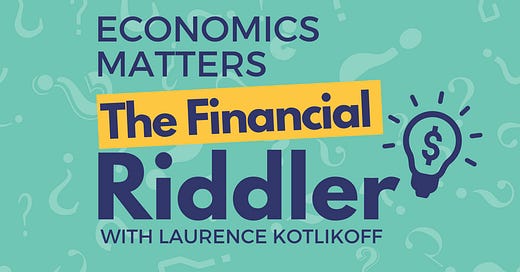Merry Christmas, Happy Hanukkah, and Happy Kwanza! And welcome back to The Financial Riddler, where losing is winning. Either way, you’ll learn new things about the global, our domestic, and your personal economy. Answers appear after each riddle. Don’t peek! Instead, scroll slowly and stop at “And the answer is.” Then check how you did.
What’s the best investment Millennials can make?
a) Buy I-Bonds
b) Pay off their credit cards
c) Buy a home
d) Oversee their parents’ Social Security collection decisions
And the Answer Is ….
The answer is d. As described here, Millennials’ parents are on track to leave $182K on the table by screwing up their collection of lifetime Social Security. The $182,000 is the median lifetime benefit loss. Hence, half of Millennial parents will forgo more than this amount simply by filing for the wrong benefits at the wrong time.
The biggest mistake being made is taking Social Security retirement benefits early. Roughly 90 percent of millennial parents should wait till age 70 to file for this benefit. Only 10 percent are doing so. “But it’s my parents’ money. I can’t tell them what to do?” No, it’s your money. If they collect less and die on time, you’ll receive less in inheritance. If they die later than expected, you’ll need to shell out more for their care because of the lower benefits they are receiving each month.
Compare $182K with $39. The $182K is the amount you are likely to make for your parents (actually, for yourself) by paying $39. That’s what my company’s Maximize My Social Security software costs. It will suggest what benefits your parents should collect, and when, to maximize their lifetime benefits. Here’s a link to testimonials about the program. And here’s a link to press articles. If you aren’t up for running the tool for your parents, shell out 11 bucks to buy your folks this NY Times Bestseller on Social Security optimization. It’s written by yours truly, fabled personal finance columnist, Phil Moeller, and PBSNewsHours’ long-time, brilliant (and funny) economics correspondent, Paul Solman.
Since 1926, the real (inflation-adjusted) return on the U.S. stock market has averaged
a) 12.6 percent
b) 10.5 percent
c) 7.4 percent
d) 4.9 percent
And the Answer Is ….
The answer is c. The average nominal return over this period was answer b — 10.5 percent. Receiving, for sure, a 10.5 percent nominal return tells you that if you invest $1,000 this year, you’ll have $1105 a year from now. But if prices rise by 10.5 percent over the year, the $1105 won’t buy you more in actual hot dogs, toothpaste, toilet paper, beauty salon services, … whatever a year from now than the $1,000 does right now! I.e., your real — inflation-adjusted return — will be zero. Real returns, which adjust for receiving your return in watered-down dollars, are what matters. But Google “stock market returns.” Virtually nothing about real returns comes up. Next, Google “real stock market returns.” What you’ll see, with a couple expression, is the same set of hits. This is testimony to the money illusion that afflicts our nation (but not players of The Financial Riddler!).
Are stocks safer the longer you hold them?
a) yes
b) no
And the Answer Is ….
b. Actually, stocks are riskier the longer your hold them. Just listen to BU Finance Professor, Ziv Bodie. As he points out, if they were safer, long-term inflation-indexed government Treasury bonds would be yielding far more than is the case. Why earn roughly 1.6 percent real (Today’s 30-year TIPS, Treasury Inflation Protected Securities) yield if you can earn, for sure, the market’s historic 7.4 percent real yield? We wouldn’t. Hence, 30-year TIPS would need to yield 7.4 percent real were stocks really a safe better. The 5.8 percent risk premium — the massive difference between the 7.4 percent and the 1.6 percent — tells you that stocks, even held for 30 years, as incredibly risky. In fact, the typical deviation — the standard deviation — in annual real stock returns since 1926 is 19.8 percent. Since the average annual return is 7.4 percent, we’re talking, roughly speaking, about the stock market’s return typically ranging from a low of negative 12.4 percent to a high of positive 27.2 percent. Of course, the actual range can be far higher. If upside is more likely than downside, why then is there a risk premium? Simple. We’re risk averse. We care lots more about the downside than the upside.
Is the divorce rate of second marriages higher than that of first marriages?
a) Yes
b) No
And the Answer Is ….
The answer is a. An estimated 41 percent of first marriages end in divorce. For second marriages, the rate is 60 percent. For third marriages, it’s 73 percent. Oscar Wilde’s quotes: “Marriage is the triumph of imagination over intelligence. Second marriage is the triumph of hope over experience.” Apparently, third marriages weren’t a thing back in Wilde’s day. Otherwise, he might have said, “Third marriage is the triumph of desperation over despair.”
How many horses, mostly working, were there in 1925?
a) 55 million
b) 40 million
c) 25 million
d) 10 million
And the Answer Is ….
The answer is c. Today there are only 7 million. The horse was obsolesced by cars and trucks. Will humans be similarly obsolesced by robots?





Hi Jeff, Here's the calculator: http://www.moneychimp.com/features/market_cagr.htm
best, Larry
Where does this number come from?
“The average nominal return over this period was answer b — 10.5 percent. “